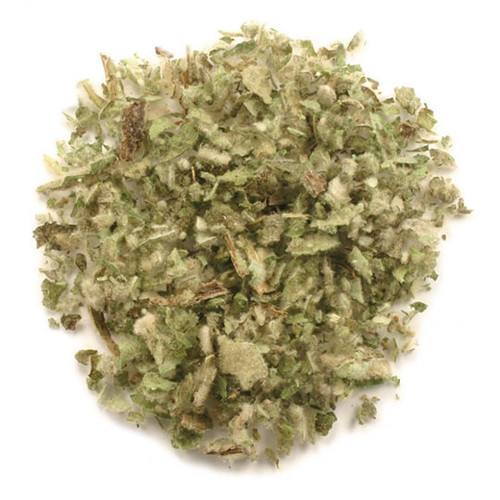Product Overview
Organic Yarrow Flowers
Loose Leaf Herbal Tea
Yarrow flowers (Achillea millefolium) bloom from June to September. There are many lovely garden varieties in hues of pink, purple and cream, but the flowers of the traditional herb are white.
A strongly astringent herb, it's also called milfoil, soldier's woundwort, nosebleed, and thousand leaf.
Botanical name: Achillea millefolium L.
Botanical Family: Asteraceae
Common name: yarrow
Synonyms: Milfoil, common yarrow, nosebleed, thousand leaf, soldier's woundwort, sumidad de aquilea (Spanish)
The Plant: Yarrow is a white-flowered perennial herb, native to Eurasia but naturalized in many temperate regions around the world, including North America.
It has been hybridized with several species and sub-species to create an array of cream, yellow, pink, red, and purple-flowered varieties that offer long-lasting flowers in the garden. The white-flowered species, millefolium, is considered the true medicinal or common yarrow in European herbal tradition, although other species are used in their native lands. The three- to eight-inch long leaves of the yarrow plant are finely divided, giving us the common name of 'milfoil,' meaning "many leaves."
The three-foot tall stalks are upright, stiff, and topped by sturdy, flat clusters of flowers. Yarrow spreads by root division and also reseeds itself. It needs sun and well-drained soils and is quite drought tolerant. The whole plant is fragrant.
In the United States, an almost identical species, A. lanulosa (native to the eastern portion of the country), and A. borealis (native to the west), were used by native Americans for a variety of ills. When the pioneers brought their yarrow (A. millefolium) with them, it soon escaped cultivation and became part of the wild yarrows used by both groups. In the spring the young leaves were used, and in the late summer, the flowers were harvested. Tao-pi pezu-ta (meaning "medicine for the wounded") is the Dakota name for yarrow.
Yarrow blooms in the summer, and the flower or tops are harvested while the plant is in full bloom. Yarrow flowers dry quickly, because they contain less moisture than most other herb flowers. Yarrow is harvested both from wild populations and from cultivated plants. While the whole plant can be used, generally just the flowers or the flowering tops are preferred because their qualities are stronger than those of the other parts of the plant.
Constituents of Note: While present at only 0.2 to 0.8%, essential oil of yarrow is an important constituent in yarrow. It has alpha-pinene, sabinene, 1.8-cineole, isoartemisia ketone and camphor as the main constituents. The oil is also used in aromatherapy and, like German chamomile oil, has a blue-green to dark-blue color due to trace amounts of chamazulene, which develops during distillation.
Quality: The white flowers of yarrow turn an ivory to light tan-yellow when dried. The aroma is camphor-like and slightly sweet, and the flavor is bitter, strong, somewhat camphor-like and aromatic.
Regulatory Status: GRAS (Title 21 182.10 and 182.20) as a spice, natural flavoring, and seasoning GRAS (Title 21 172.510) as a flavoring agent in foods Dietary Supplement
Did you know? Yarrow stems were used as the original object for the casting of the hexagrams of the I Ching, a divination system described in one of the oldest known classic Chinese texts. While other objects replaced it over time, the yarrow stalk method was reinvented and is still used today.
Directions: To make yarrow herb tea, cover one teaspoon of yarrow with one cup of hot water, cover and let stand for five to ten minutes. The tea is quite bitter; a bit of honey or flavorful, complementary herbs, such as peppermint or spearmint, can be added if desired.
Suggested Uses: Yarrow is considered a pungent, bitter, cold herb that expels heat. It offers support during cold and flu season* when taken as a hot tea. A traditional herbal tea that combines one part each of yarrow, spearmint and elder flowers is also used for this purpose. Yarrow is considered a bitter tonic, and, like other bitter tonics, it can be taken before and after meals. A tea blend of linden flowers and yarrow flowers is traditionally consumed to help combat restlessness. Yarrow is also a popular tincture for first aid purposes.
* Disclaimer: This statement has not been evaluated by the FDA. This product is not intended to diagnose, treat, cure or prevent any disease.
Caution/Safety: The Botanical Safety Handbook* classifies yarrow as: Class: 2b Herbs not to be used during pregnancy.
Note: discontinue external use 'in the event of itching and inflammatory changes in the skin.' Per the German Commission E Monograph** for yarrow, there are no known side effects or drug interactions. There is a possibility of allergy to yarrow, especially in those with allergies to the aster plant family.
*Michael McGuffin, ed., American Herbal Products Association's Botanical Safety Handbook, (New York: CRC Press, 1997)
**Mark Blumenthal, ed., The Complete German Commission E Monographs, (Austin TX: Integrative Medicine Communications, 1998







